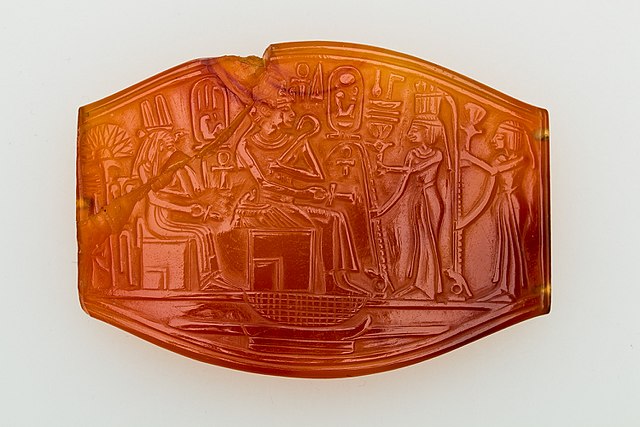Carnelian
Carnelian is a brownish-red mineral commonly used as a semi-precious gemstone. Similar to carnelian is sard, which is generally harder and darker (the difference is not rigidly defined, and the two names are often used interchangeably). Both carnelian and sard are varieties of the silica mineral chalcedony colored by impurities of iron oxide. The color can vary greatly, ranging from pale orange to an intense almost-black coloration.
History of human use
Carnelian was recovered from Bronze Age Minoan layers at Knossos on Crete in a form that demonstrated its use in decorative arts; this use dates to approximately 1800 BC. Carnelian and sard were used for Assyrian cylinder seals, Egyptian and Phoenician scarabs, and early Greek and Etruscan gems.
Carnelian was used widely during Roman times to make engraved gems for signet or seal rings for imprinting a seal with wax on correspondence or other important documents.
In Revelation 4:3, the One seated on the heavenly throne seen in the vision of John the apostle is said to "look like jasper and sardius." And likewise it is in Revelation 21:20 as one of the precious stones in the foundations of the wall of the heavenly city.
Connection to stellar gods
There is a Neo-Assyrian seal made of carnelian in the Western Asiatic Seals collection of the British Museum that shows Ishtar-Gula as a star goddess. She is holding a ring of royal authority and is seated on a throne. She is shown with the spade of Marduk (his symbol), Sibbiti (seven) gods, the stylus of Nabu and a worshipper. An 8th century BC carnelian seal from the collection of the Ashmolean Museum shows Ishtar-Gula with her dog facing the spade of Marduk and his red dragon.
Additionally, four of the decans of Egyptian astrology have carnelian as their primary mineral:
Among the Archangels of the Zodiac, two angels have carnelian as their mineral:
